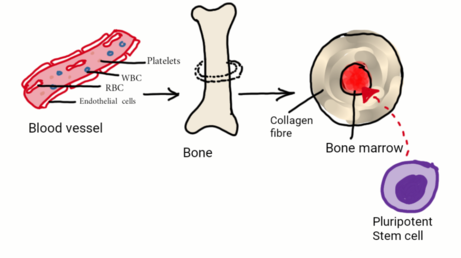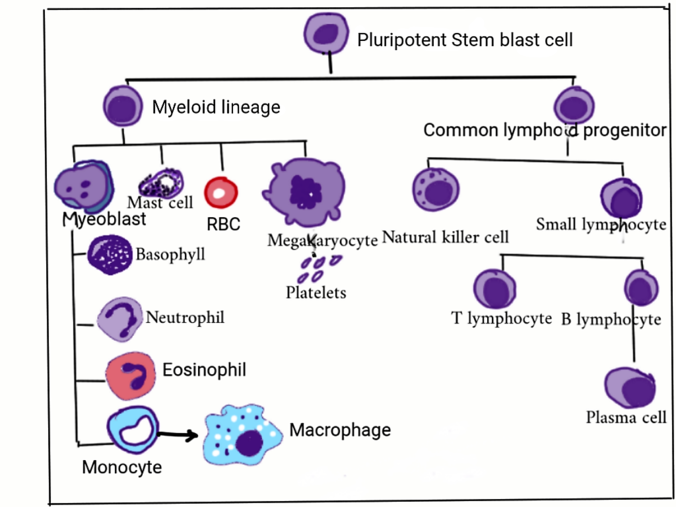Blood Composition, Formation and Functions
Blood is a fluid connective tissue which helps in transportation of necessary substances from one part of our body to other. Total volume of blood in human female is 4-5 litres and in male is 5-6litres. Blood is composed of formed elements (blood corpuscles) which remain embedded in fluid part called plasma.
| Composition of Blood |
Blood that flows inside the blood vessel (composed of endothelial cells ) is composed of fluid part called plasma and formed elements called blood corpuscles. Besides these, other important substances are also found and transported through blood. Following is a schematic diagram.

From the above figure 1, it is now clear about the constituents of plasma. But what about Formed elements or blood corpuscles) which exhibit about 45% of the volume of blood? The most abundant blood corpuscles found are` Erythrocytes (RBC). Other blood corpuscles include Leucocytes (WBC) and Thrombocytes (Platelets).
Detailed account of Formed elements ( Blood corpuscles)
| Erythrocytes (RBC)
1. Non nucleated, circular, biconcave dumble shaped cells. In male (4.2-5.8 million RBC) and in female ( 3.6-5.2 million RBC )
2. RBC are formed in the bone marrow of ribs and vertebrae.
3. Each disc shaped RBC is 7.5µm in diameter.
4. Live for 120 days in males and 110 days in females. They disintegrate in spleen and liver.
5. They contain Haemoglobin which carries oxygen.
|
Leucocytes (WBC)
1. Nucleated clear cells meant mainly for protection against invading micro organism. 2. They are formed in red bone marrow and lymph glands. Life span of human leucocyte is 12 – 13 3. They are mainly of two types: i)Granulocytes: cytoplasm is granular with large irregular nuclei. Produced in bone marrow. They are further divided into: Eosinophil or Acidophils: Granular cytoplasm with bilobed nucleus and stains with acid dyes eosin; meant for destruction and detoxication of protein origin toxins. Basophils Coarse granular cytoplasm with bi or tri lobed nucleus and stains blue Neutrophils Nucleus polymorphic in nature with granulated cytoplasm with multilobed nucleus and they take very faint basic stains. In contact with any bacteria they engulf, digest and destroy them. Agranulocytes : Simple nuclei with agranulated cytoplasm. They are of two types: Lymphocytes Cells with large eccentric nucleus and less cytoplasm.They are commonly found in lymph nodes, thymus, spleen. They produce antibodies.Less motile in nature. There are B lymphocytes which kills bacteria ; T- lymohocytes which acts against viruse and Natural killer cells (NK cells) Monocytes: Cells have kidney bean shaped or oval nucleus with large cytoplasm and are motile in nature. They helps in engulfing bacteria by phagocytosis. |
Thrombocytes
(Platelets)
1.Flat granular corpuscles formed in the red bone marrow .
2. They contain thromboplastin which helps in clotting of blood. |
Mechanism of formation of blood (Hematopoiesis)
‘Hemato’ means blood and ‘poiesis’ means to
form. Blood flowing inside a blood vessel

are not synthesized in thes ame place.
Instead they are formed from pleuropotent
(can give rise to any type of blood cell)
hematopoietic stem cells which
originates from bone marrow present
inside a bone. Hematopoietic cells
give rise to cells of two different lineages.

Haematopoietic cell develops inside the bone marrow of limb bones, vertebrae, sternum or arm bone. They are pleuripotent in nature i.e, they can give rise to any type of blood cell. The immature blood cell is called Blast cell which further divide to form cells of either myeloid or lymphoid progenitor cell. These further will give rise to different types of blood cells. Note here White blood cells or leucocytes have cells of both lymphoid and myeloid lineage.
Mechanism of blood clotting
1.When a blood vesse is damaged, it releases a mixture of lipoprotein and phospholipids called Tissue factor or Thromboplastin. This in presence of certain factor of blood is converted to Prothombinase or Thrombokinase/
2. Prothombinase converts plasma protein Prothombin into active Thrombin. Prothombin needs Vit K in liver for its synthesis.
3.Active enzyme Thrombin can now convert plasma protein Fibrinogen to Fibrin. Fibrin forms a fibrous network of clot.
4. Formation of thrombus or blood clot with in intact blood vessel is called Thrombosis.
*** Thrombosis occurring with in an artery may block the artery preventing blood and oxygen flow. When it occurs with one of the coronary arteries supplying heart muscles , it is known as Coronary Thrombosis, a condition called heart attack.
A thrombosis in the arteries supplying blood to brain causes cerebral thrombosis, a condition called cerebral stroke. When a fragmented clot enters the circulating blood
Function of blood
- Transport of oxygen from lungs to tissue and carbon dioxide from tissue to respiratory surface
- Transport of nutrients from intestine to liver and then to whole of the tissue for cellular activities. These include glucose, amino acids, polypeptides, cholesterol, amino acids, minerals, vitamins and water.
- Waste products like urea, uric acid are eliminated by blood to kidney as urine, lungs, skin for elimination.
- Endocrine glands produce hormones which are distributed by blood to the vital tissues.
- Amphoteric property of Plasma proteins helps to maintain the pH of the blood.
- Blood maintains water balance by exchange of water between tissue fluid and blood.
- Blood helps in transporting of heat from deeper tissue to surface of the body
- Blood helps to develop immune system in our body and helps in defence mechanism against invading microorganism..
- Blood cells like Monocytes helps in phagocytosis; Lymphocytes helps in producing antibodies which kills bacteria and viruses.
- Blood posses certain coagulating agents like Thrombin and Fibrinogen which helps in coagulation of blood.
|
